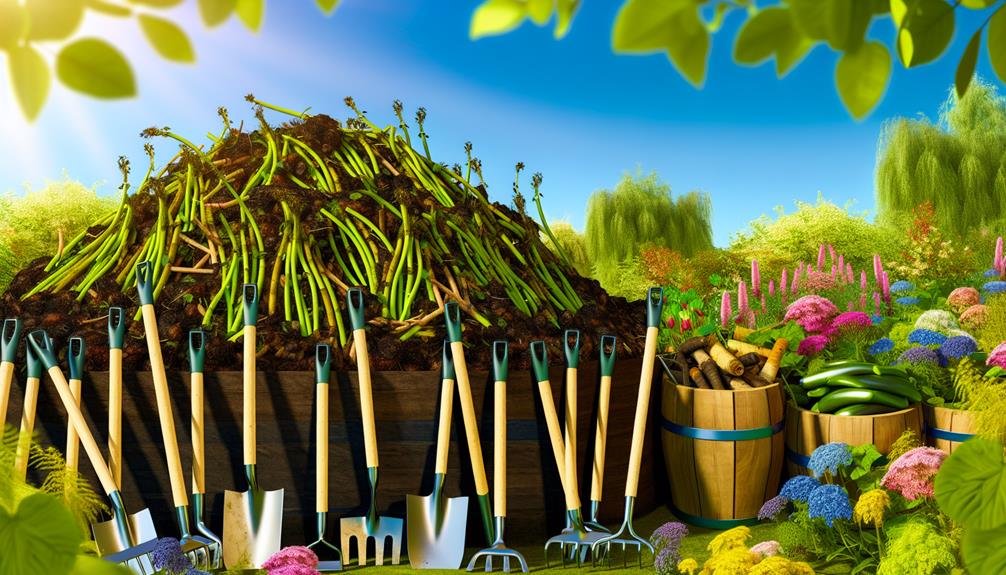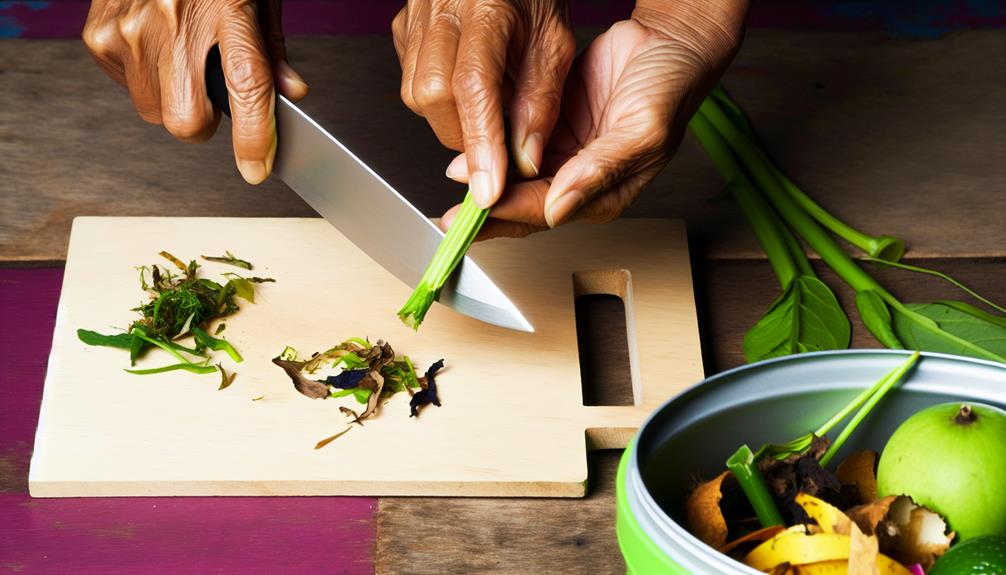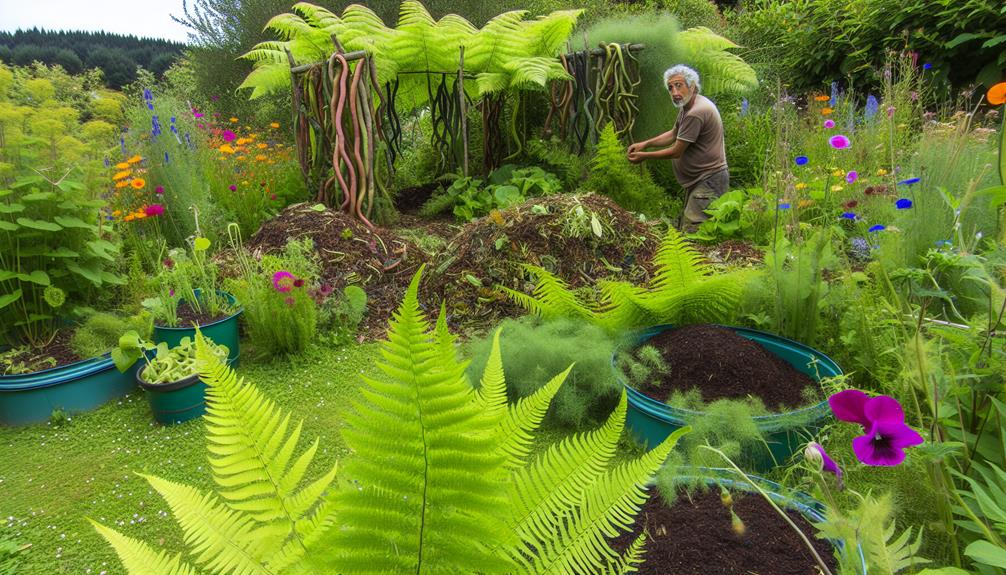

Yes, you can compost weed stems effectively. Start by shredding the stems into one-to-two inch pieces using garden shears or a shredder. This helps them break down faster. Make sure your compost has a good balance of green (nitrogen-rich) and brown (carbon-rich) materials. Keep the compost as damp as a wrung-out sponge and check moisture levels regularly to avoid pest attraction and nutrient imbalance.
If done correctly, composting weed stems enriches your soil with valuable nutrients and promotes healthy plant growth. Consider other uses like mulch or crafts if composting isn’t ideal. Explore more for detailed tips.
Composting weed stems helps you reduce yard waste and enrich your soil with valuable nutrients. By including these often-overlooked parts of plants in your compost pile, you’re not only minimizing the amount of waste that ends up in landfills but also creating a richer, more fertile soil for your garden.
This process of nutrient enrichment guarantees your plants thrive, providing them with the essential elements they need for robust growth.
When you compost weed stems, you’re actively contributing to a more sustainable environment. Instead of discarding these plant parts, you’re turning them into a beneficial resource. This approach aligns with the broader goals of reducing waste and promoting eco-friendly practices.
Plus, the compost you produce is a fantastic amendment for your garden soil, improving its structure, moisture retention, and overall health.
To get started, chop the weed stems into smaller pieces to speed up the decomposition process. Mix them with other compostable materials like kitchen scraps and dry leaves. Regularly turning the pile ensures even decomposition and faster results.
Also Read: Can You Compost Body Wash?
Despite its many benefits, you should be mindful of a few potential drawbacks when composting weed stems. One major concern is pest attraction. Weed stems can sometimes lure unwanted critters like insects or small rodents into your compost pile. These pests aren’t only a nuisance but can also disrupt the composting process and spread to your garden. To minimize this risk, make sure your compost is well-aerated and balanced with other organic materials.
Another issue to take into account is nutrient imbalance. Weed stems are high in carbon but low in nitrogen. If you add too many weed stems without balancing them with nitrogen-rich materials, your compost might decompose much slower. This imbalance can lead to a less effective compost, which won’t provide the necessary nutrients for your garden plants. To avoid this, mix weed stems with kitchen scraps, grass clippings, or other green materials.
While these potential drawbacks shouldn’t deter you from composting weed stems, being aware of them helps you take proactive steps. By managing pest attraction and nutrient imbalance, you can create a healthy, effective compost that benefits your garden and environment.
Before you start composting weed stems, make sure to properly prepare them to guarantee efficient decomposition. The first step is cleaning tools. You don’t want any contaminants or residues from other plants interfering with your compost. Use a brush or cloth to clean your cutting tools and make certain they’re sanitized. This step helps prevent the introduction of unwanted bacteria or pests into your compost pile.

Next, let’s talk about shredding stems. Weed stems can be quite tough and fibrous, making it harder for them to break down quickly. By shredding the stems into smaller pieces, you increase the surface area, allowing microorganisms to work more effectively. You can use garden shears, a shredder, or even a lawnmower to chop the stems into manageable bits. Aim for pieces that are about one to two inches long.
Once your tools are clean and the stems are shredded, you’re ready to add them to your compost pile. Remember, the goal is to create an environment where these materials can decompose efficiently. Proper preparation not only speeds up the composting process but also ensures a healthier, more balanced compost mix for your garden.
Also Read: Can You Compost Blood?
To ensure your weed stems break down effectively in the compost pile, focus on maintaining the right balance of green and brown materials. Start by using a layering technique. Alternate between green materials like vegetable scraps or grass clippings and brown materials like dry leaves or cardboard. Weed stems are considered brown material, so layer them accordingly.
Maintaining a proper moisture balance is essential. Your compost should be as damp as a wrung-out sponge. Too much moisture can lead to a soggy, anaerobic pile, while too little will slow down the decomposition process. Regularly check the moisture levels and adjust by adding water or dry materials as needed.
Here’s a quick guide to help you balance and layer your compost pile:
| Green Materials | Brown Materials | Tips for Layering |
|---|---|---|
| Vegetable scraps | Dry leaves | Alternate layers evenly |
| Grass clippings | Cardboard | Aim for 3-4 inch thick layers |
| Coffee grounds | Weed stems | Mix materials as you layer |
| Fruit peels | Shredded paper | Add water if too dry |
| Fresh garden waste | Straw or hay | Turn pile regularly |
Also Read: Can You Compost Black-Eyed Peas?
If composting weed stems isn’t feasible, you can explore several alternative methods to dispose of them effectively. These methods not only help you manage waste but also find creative uses for weed stems.

Yes, composting weed stems can attract pests. For effective pest prevention, make sure your compost location is well-maintained, aerated, and balanced. Stick to community guidelines, and your compost pile will remain a welcoming, pest-free zone.
When you compost weed stems, their decomposition time depends on microbial activity, usually taking several months to a year. By sustaining a balanced compost pile, you’ll guarantee your community’s efforts speed up the breakdown process.
When handling weed stems for composting, don’t worry about significant health hazards. Just use proper composting techniques like wearing gloves and ensuring adequate aeration. You’ll contribute to a safe, eco-friendly composting community.
Yes, you can compost weed stems alongside other garden waste. Just mix them well into your compost layers. By integrating them, you’re contributing to a balanced, thriving compost community that everyone benefits from.
Weed stems can enrich your compost, adding to soil enrichment. They don’t greatly boost nitrogen content, but they contribute to a balanced mix. Including them helps create a sense of community among fellow composters aiming for sustainability.
In conclusion, composting weed stems is a viable option if you adhere to best practices. Make sure they’re chopped into smaller pieces to speed up decomposition. Balance your compost with green and brown materials.
Be mindful of potential drawbacks, such as slow breakdown or seeds sprouting. If composting isn’t suitable, consider alternative uses like mulching or creating biochar.
By managing these factors, you’ll effectively recycle weed stems and enrich your compost.
